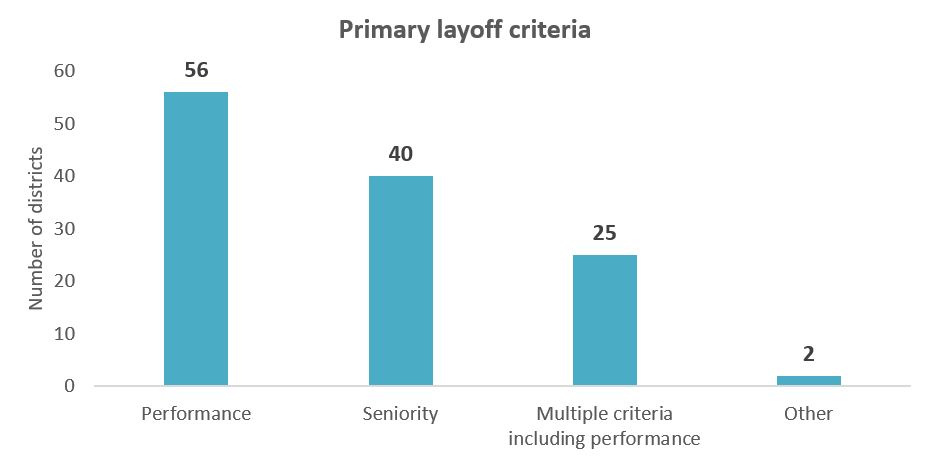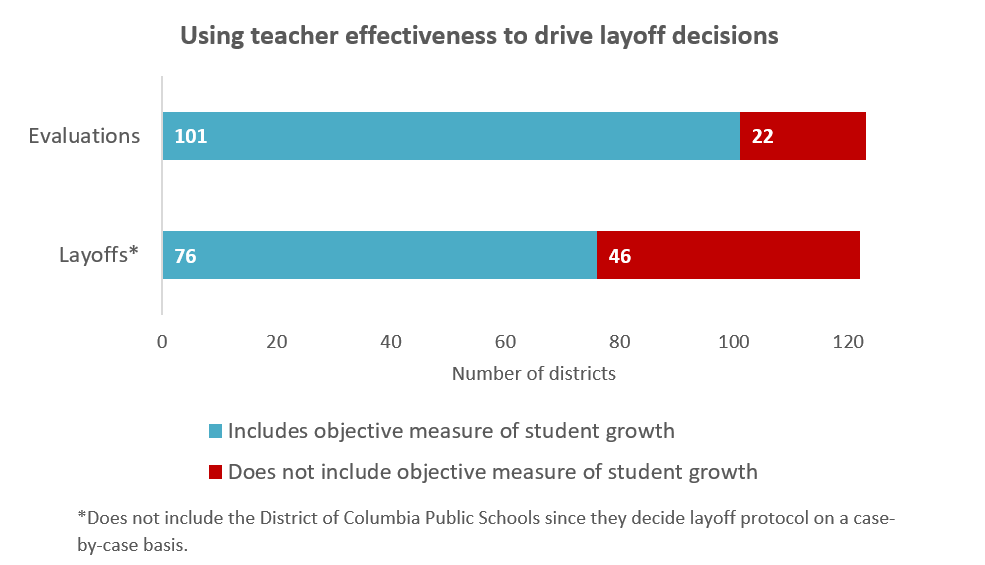No district wants to be in the position of laying off teachers, but financial hardships sometimes make it a necessity. While the rule of the day used to be last-in, first-out (where the least senior teachers are the first to be laid off), over the past decade, states and districts have been moving away from these quality-blind layoffs and incorporating teacher performance into their decisions.
In this District Trendline, we examine the layoff policy landscape in 123 large school districts across the country, zooming in on the use of teacher performance in layoffs. We also examine what states have to say on the subject.
How do districts lay off teachers?
When districts are making the decision to lay off teachers, they need to apply some criteria to determine which groups of teachers are let go first. While seniority is still the main criterion for layoffs in many districts, the majority of large districts are now also using performance as a factor. Among the largest districts in the country, 45 percent (56 districts) use performance as the primary factor and an additional 20 percent (25 districts) use performance as one of the factors.
In spite of this progress, a full third of large districts still rely on seniority as the primary factor for deciding which teachers are laid off.
The issue is complicated by the fact that some districts apply different layoff rules depending upon a teacher's tenure status. Quite a few (42 percent of the sample) continue to lay off non-tenured or probationary teachers before tenured or non-probationary teachers. That practice doesn't mean, however, that performance may not be considered. When it comes to which non-tenured or probationary teachers must be laid off first, 14 of these districts explicitly allow performance to be the primary factor. That's why these 14 districts are included in the "multiple criteria" category in the graph above.
Other districts in the multiple criteria category include districts that give performance and seniority equal weight or that list a variety of criteria that can be considered when making layoff decisions with no specific order in which the criteria are applied.
The two districts in the other category include the District of Columbia Public Schools where there is no state law governing layoffs and procedures are determined when necessary, and Granite School District (UT) whose policy states only that the needs of the school district will be the deciding factor when determining whom to lay off.
Do districts use teacher effectiveness to layoff teachers?
While applying any measure of teacher performance, regardless of source, during layoffs is better than not considering performance at all, the fairest criteria to apply are some objective measure(s) of teacher performance as measured by student learning and growth. These need not be state test scores, but districts should strive to identify a source of objective data on performance in such considerations. Over 80 percent of the large districts in our sample incorporate some objective evidence of student learning or growth into their teachers' evaluation ratings but, surprisingly, about a quarter of them do not use that data to decide whom to lay off.
The power of state policy
State policies on layoffs can lead their districts to consider teacher effectiveness--or they can prevent them from doing so. Only 19 states require districts to consider teacher effectiveness in layoff decisions. To appreciate how important state leadership is on this issue, the vast majority of school districts in the sample (89 percent) follow state policy when it comes to using teacher effectiveness in layoff decisions.
There are nine districts that do more than their states require. These districts give greater priority to teacher performance than the state requires them to give. On the other hand, nine states require that seniority be the only factor in layoffs. As a result, 10 districts in the sample have data on teacher effectiveness but are barred from using them in layoff decisions.
A number of states (17) choose not to play much of a role in these crucial matters. In those states, among the 26 districts we track, only about a quarter consider teacher effectiveness in layoff decisions.
States have a key role to play in ensuring teacher effectiveness is used in layoff decisions. As states have changed laws to allow or require that layoff decisions consider evidence of effectiveness, district policy has shifted to comply. Given the importance of great teaching for student learning, including effectiveness data when making layoff decisions is essential.
Explore district layoff policies in the Teacher Contract Database and learn more about state policies in our new publication Walking the tightrope: Teacher effectiveness and personnel policies.


